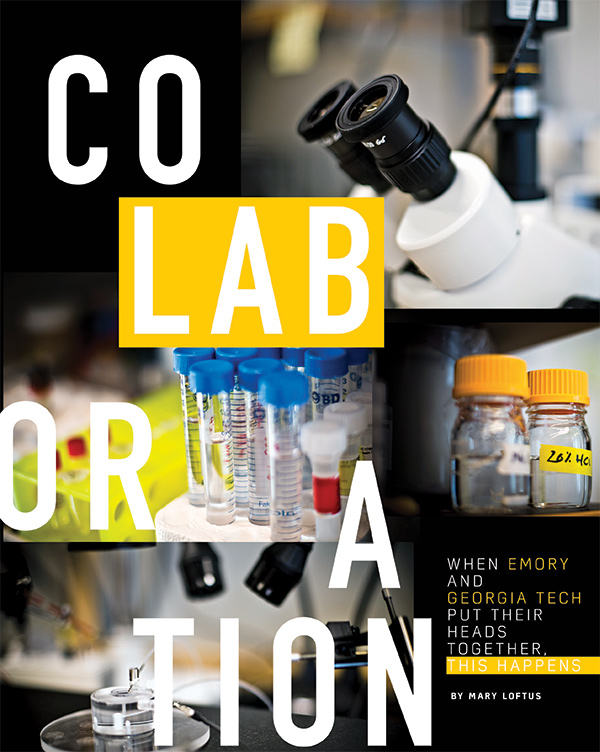Co(lab)oration
When Emory and Georgia Tech put their heads together, this happens

The Georgia Tech/Emory shuttle, bearing a bright Yellow Jacket logo, runs hourly between Emory’s Woodruff Circle and the Georgia Institute of Technology’s biotech campus. It’s a bumpy six-mile ride through tony suburbs and over narrow city streets.
This particular Wednesday is the first day of fall classes for Emory, and Georgia Tech classes started the week before. The small bus is filled with passengers flipping through academic journals, plugged into smartphones, and watching Atlanta pass by out the window.
Tech students Nathan Neuhart and Jordan Varghese are headed to Emory University Hospital for medical records needed by Professor Cassie Mitchell 09PhD, a biomedical engineer, for her lab’s research on Lou Gehrig’s disease. Leanna Parchment 15C, a dual math and biomedical engineering major, is traveling between Emory and Tech for classes.
On the return trip, Hiba Zafar 16C, an Emory sophomore from Marietta majoring in “either psychology or neurobiology,” is commuting across town to visit her sister, Madiha, a senior biomedical engineering major at Tech. And Wafa Soofi 15PhD, a third-year graduate student in the Wallace H. Coulter Department of Biomedical Engineering at Georgia Tech and Emory, is attending a resume workshop and company recruitment session at Tech. Soofi works in the Astrid Prinz biology lab at Emory researching the neural networks of crustaceans. “One reason we use crabs as our model system is that certain neurons can be unambiguously identified between animals,” she says. “That’s really invaluable for experiments.”
Another graduate student in the Georgia Tech-Emory biomedical engineering program, Renee Cottle 14PhD, is traveling from Professor Gang Bao’s lab at Tech to Associate Professor David Archer’s lab at the Emory-Children’s Center. “I am developing a method using micro-sized needles for directly loading stem cells with nucleases, with the goal of changing the gene mutation that causes sickle cell disease,” she says. “Corrected stem cells can potentially replace diseased cells with healthy red blood cells in a patient as a long-term therapy.”
Passengers going back to Tech disembark onto Ferst Street, spinning off into the Whitaker Building, home of the Department of Biomedical Engineering, or the Petit Institute for Bioengineering and Bioscience building, or the Quad Café, also known as “the lab,” which does a brisk business in green juice, smoothies, and coffee refills and decorates its tables with oversized beakers.
The shuttle runs that connect Emory’s vast medical and life sciences research complex with Tech’s engineering and biotech centers seem less like commuter routes than busy neural pathways, transmitting vital information to and from these central academic hubs. So many research partnerships now exist between Emory and Tech that if gold-coated nanofiber bundles ran between each of them, a glowing web of interconnection would emerge.
Georgia Tech’s executive vice president for research, Stephen Cross, has a background in computer and electrical engineering and artificial intelligence. He says innovation is born not only from invention and insight but also from a willingness to seek real-world solutions.
“Within a culture of mutual respect, engineers and physicians look at problems from different perspectives to mutually discover game-changing approaches to improve the human condition,” he says. “Innovation is sparked from such interdisciplinary interactions. One example, which was developed with support from the Coulter Foundation, is a minimally invasive procedure for delivering therapeutic devices to a beating heart, making this routine for all surgeons.”
Emory’s vice president for research in the Woodruff Health Sciences Center, David Stephens, is a scientist whose background is in infectious diseases.
“The partnership with Georgia Tech and Emory in clinical and translational research, information technology, and other areas is unlocking new treasures of innovation,” he says. “The Remotoscope for assessment of middle ear infections through an iPhone is a great example of successfully applying engineering and technology principles to address medical problems, potentially saving time and reducing expense.”
The Wallace H. Coulter Department of Biomedical Engineering, one of the few such joint departments in the country, is ranked second among biomedical engineering graduate programs by US News & World Report, with about 150 graduate students and 1,387 undergraduates enrolled.
“We’re an audacious and improbable success story—a visionary partnership between a leading public engineering school and a highly respected private medical school,” says Coulter Chair Ravi Bellamkonda, a biomedical engineer who specializes in regenerative medicine and the nervous system. “Thanks to these origins, at fifteen years young, innovation and risk-taking are embedded in our DNA.”
Bellamkonda divides his workweek between Emory and Georgia Tech. With the opening of Emory’s new Health Sciences Research Building on Haygood, adjoining Children’s Healthcare of Atlanta, he says the Coulter department’s physical presence at Emory will continue to grow. “This is the first time we’ve been in one coherent space,” he says, “which will lead to even more collaboration.”
What’s a six-mile shuttle ride, after all, if it can help cure a brain tumor, fix a child’s damaged heart, prevent blindness, reduce seizures, or stop the spread of a potential flu pandemic?





